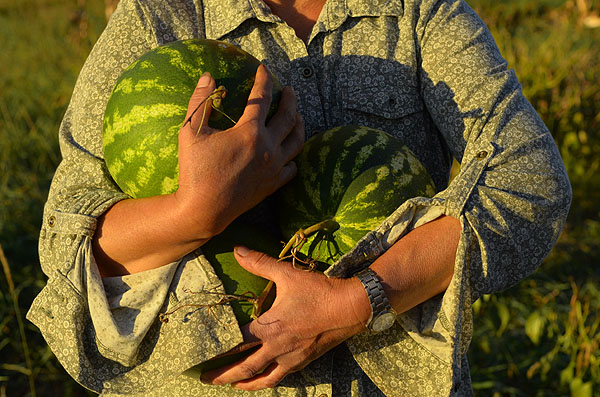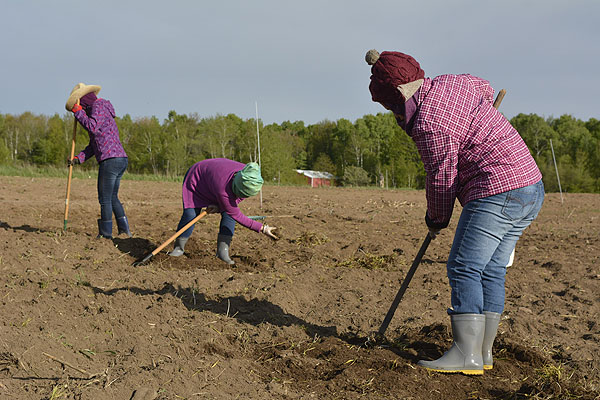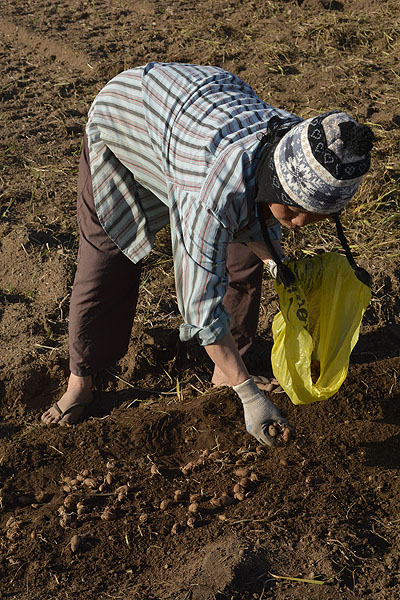Hmong Gardeners in America’s Dairyland
A garden isn’t just a patch of dirt where we plant vegetables, herbs, and flowers. A garden is a chronicle of culture. What we choose to grow often reflects our ethnic identities and customs that span generations. One tiny seed can be a tangible link between the world our ancestors knew and the world we inhabit today.
Perhaps that’s why immigrant families and communities often convene in the “sacred micro-landscape” of a garden, writes anthropologist Krystal D’Costa. With dirt beneath their feet, elders teach youngsters about the foods they traditionally eat and the care those plants need to thrive. History and tradition, as much as agricultural science, are taught, and learned, in the outdoor classroom.
You’ll find gardens like these in north-central Wisconsin. Drive Interstate 39 north from Madison toward Wausau. Turn east on Highway 153, then jog north on County Road X. In this patchwork landscape of farms, you’ll find a 40-acre property with the northwest portion divvied up into 60 plots, each one cultivated by a gardener who has roots in Southeast Asia.
Every June, families gather, wearing boots and bearing tools, to weed the dark brown soil and carve new rows for corn, beans, melons, potatoes, cucumbers, eggplants, bitter greens, and fragrant herbs. Many of these plant varieties have no English names. Hmong immigrants brought these plants and seeds from the mountains of Laos, to be planted in the flat northern reaches of America’s Dairyland—old flavors propagated in a new homeland.
Since the Vietnam War ended 41 years ago, more than 200,000 Hmong have fled Southeast Asia. Many had worked for or fought alongside U.S. forces, and they sought refuge in the United States. Tens of thousands landed in the Midwest, where farming is a way of life, just as it was (and still is) for Hmong families in Laos. The demographic makeup of small towns like Wausau shifted as waves of refugees arrived.
Jim Harris was the principal of a public elementary school in nearby Weston at the time, and he watched as his community evolved. He wanted to know more about the newcomers—their histories, their stories. He started with the Hmong in his town. And eventually he began traveling to Laos and returning home with Hmong cultural artifacts—garden tools, kitchen utensils, weaving looms, and the stuff of everyday village life. (So much stuff, it fills his basement and an entire storage unit; someday he hopes to have a museum.)
Eventually, Harris retired as a principal, and he and his wife, Marty Harris, founded the nonprofit We Help War Victims. Every year, he spends a few winter months in Laos, hiring a clearance team to remove unexploded American-made bombs that threaten civilians—predominantly farmers—throughout Laos today. (You can read more about his work—and the food his team eats—in my two previous posts.) Then, every spring, he returns to his farm where he and his wife offer garden plots to local Hmong growers. “Marty and I have been slaves to the garden and have had so much fun,” he emailed me recently. “I spent six to eight hours a day on my 60-year-old tractor tilling the gardens, mowing the borders.”
Gardening is a family affair, Marty Harris told me. Relatives often request multiple plots to share. “Maybe three of those are a mother, a daughter, and a grandmother,” she said. Women bring toddlers to the field, and family members divide the workload.
“We just do it because my parents, they do it,” a university student named Lee Lor told me last season while raking the soil with her family. She likes the work—it’s good exercise, she said. “And it’s nice to have fresh food on the table.” She plants corn, pumpkin, squash, leafy lettuce, tomatoes, and other vegetables. “I do a lot of traditional food,” she said. “I like chicken with tomatoes and cilantro and onions. … I also like pork with peppers and onions.” She thinks homegrown vegetables are healthier than the typical American college diet.
Lor was born in a refugee camp in Thailand and moved to Wisconsin in 1995. “I left at such a young age that I don’t have much memory of Thailand,” she said, “but I’ve heard stories.” The garden is a link to her Hmong heritage.
Many of the Hmong elders who live near Wausau have distinct memories of their life in Asia and their escape from war or the communist government that followed. Some crossed the Mekong River, clinging to bamboo poles and inner tubes. Others were child soldiers and have traumas that linger today. The transition to Midwest life was not easy for the Hmong, and ethnic tensions have often divided Wausau. They still do today.
Some of the Hmong say they find solace in a garden. And many remember clearly the farms and gardens they tended in the mountains. “In Sam Neua, I made a garden, too. I planted corn and rice and squash, everything,” a 70-year-old woman named Mao Vang Chang told me. “Everybody had a garden—big garden—and a pig and cow.” She came to the United States in 1982.
It’s this generation the Harrises initially aimed to help through the garden program.
“When we first started, the target group for us were elderly women in the family who were despondent, didn’t speak English,” Jim Harris said. Many older Hmong relied on their younger children to communicate in public—shopping, paying bills, visiting the doctor. The Harrises figured a garden might boost spirits, as well as health. They started with 20 plots. When the economy tanked in 2007, demand soared “because the Hmong were the last hired, first fired,” he said. The gardens helped.
Today, there are 60 plots on offer, and they’re always full. Marty Harris handles the organizing, and her multiple phones ring in a nonstop chorus during planting season. “It’s a real adventure,” she said. There’s a bit of underground bargaining and backdoor dealing as extended families niggle over who gets which space where. But “somehow, magically,” she said, “at the end of the whole thing, it all works out.”
A couple years back, I visited a few Hmong families in the pith of winter: ice on the sidewalks, frost on the windowpanes. But inside, thermostats soared. Pumpkins, squash, and root vegetables were crammed into living rooms and basements. Potted herbs thrived beneath grow lights.
“If the family gardens,” Lor told me, “that’s pretty typical.” Much of what a family needs to eat through a frigid winter is all right there in the house. The Hmong never experienced snowstorms and subzero temperatures in Laos, as they do in Wisconsin. Their mountain fields never froze hard beneath their feet. But these are families whose lives depend on the ability to adapt.



































